|
Hierarchy of Shapes
|
The hierarchy of shapes.
This page is about the order of creation, from the primary basic elements to the most complex combinations of these basic elements.
Primary basic elements aren't necessarily small. Searching for the smallest element might be as smart as searching for the smallest number. What does count is how basic it is, and how organized the
structure. A random mix of elements is just a random mix of elements. A simple repetition is a structure, but a bit more complex structures can be more beautiful.
I call any structured combination a 'shape', no matter how simple or complex it is, as long as it is contains little randomness.
In this text, I can't describe the reality of this universe, because I don't know what exactly are the primary basic elements. I'm just trying to understand the logic behind the shapes in our universe, if there is logic to it.
This search in shapes has two directions: towards less complexity and towards more complexity. Going towards less complexity will bring less combinations, and going towards more complexity will bring more and more combinations.
|
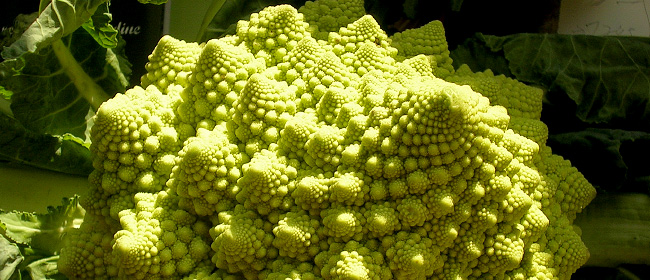 Romanesco broccoli is an edible flower of the species
Romanesco broccoli is an edible flower of the species
Brassica oleracea, and a variant form of cauliflower.
An imaginary universe, example.
The numbers 0 to 9 is what everybody is familiar with, good for this first example.
Level 1
This level consists of the 'primary basic elements':
0, 1, 2, 3, 4, 5, 6, 7, 8, 9.
These are the 10 different numbers, that make up all larger whole numbers in this imaginary universe.
Level 2
This level consists of combinations of 2 primary basic elements:
00, 01, 02, 03, 04, 05, 06, 07, 08, 09, 10, 11, ... up to 99.
That is 100 different combinations.
OK, that
is nothing interesting. Just counting as usual.
Level 3 shall have 1000 combinations.
Level 4 shall have 10000 combinations.
So let's now make a small chance, and start over again.
The numbers 5 and 7 are now erased from existence!
Which has enormous consequences for the combinations of the levels above.
Level 1
This level consists of the primary basic elements:
0, 1, 2, 3, 4, 6, 8, 9.
That is 8 different numbers.
Level 2
This level consists of combinations of 2 primary basic elements:
00, 01, 02, 03, 04, 06, 08, 09, 10, 11, ... up to 99.
That is 64 different combinations.
An easy way to calculate this is: the amount of numbers to the power of the number of positions. In this case: 8^2 = 64
Level 3 shall have 8^3 = 512 combinations.
Level 4 shall have 8^4 = 4096 combinations.
Level 4 now, has 10000-4096 = 5904 less combinations, as a result of erasing just 2 primary basic elements.
Let's make a change ones more: remove 0 and 1, and add a new symbol "œ" in the beginning. Now this imaginary universe is very different from what we are used to.
Level 1
This level consists of the primary basic elements:
œ, 2, 3, 4, 6, 8, 9.
That is 7 different symbols.
Level 2
This level consists of combinations of 2 primary basic elements:
œœ, œ2, œ3, œ4, œ6, œ8, œ9, 2œ, 22, ... up to 99.
That is 49 different combinations.
Level 3 shall have 7^3 = 343 combinations.
Level 4 shall have 7^4 = 2401 combinations.
When now translating this simple example to our reality, it becomes really really interesting!
- It is the character of the primary basic elements, that dictates what combinations in the higher levels are possible.
- Once you know the character of the primary basic elements of this universe, you can, in theory, know what unknowns are possible.
- Any change in the primary basic elements, however small, will alter the shape of the universe dramatically.
- If you can alter the primary basic elements, you can make the impossible possible, and the possible impossible.
The real primary basic elements of this universe
Unknown are the real primary basic elements. Luckily there are some people on this planet that do actively search for it. As for example the people of the Large Hadron Collider. What I hear myself repeating though, is "These primary basic elements don't have to be small. Searching for the smallest particle might be as smart as searching for the smallest number". What counts is how basic it is, not how small. But I'm sure they know that.
The number of different primary basic elements will be very small, because they are at the end of the road towards the most simple. About how many? At least two, because it is impossible to make combinations with just one.
I think space and energy are two good candidates, but I can't be sure. Space would the medium, and energy a change in that medium, giving motion and shape to the space. I can't imagine a third one yet. Time? I don't believe in Time.
Will primary basic element type 'A' be just one big universal thing, or will there be a huge amount of them? And if there is a huge amount, will each of them be exactly the same, or will each one be similar but unique?
The most basic parts (the primary basic elements) may be the most basic, but that doesn't necessarily say that they are simple. Bits of digital code is simple; a bit is a 0 or a 1, all 0 bits are exactly the same, as are the 1 bits. What about primary basic element type 'A'? Will it be as simple and static as a computer bit, or will it be complex and even dynamic?
==== so far rewritten
Shapes are a combination of two or more different kinds of lower level parts. Which is possible because let's say there is attraction between them. Not all attractions are equal though.
Imagine the attraction between two is being too weak. Than that combination is not available for all more complex combinations.
Some combinations of shapes are more stable than others. Some "want" to bound and become like one, probably by sharing part of their structure. Some combinations of shapes are impossible: you can bring them together but they just won't bound.
Some combinations of shapes want to join, but will not bound, they "want" to be together, but not become as one entirely.
A nice illustration of a combination of 2 is: waves (energy) in water (a medium). Waves travel over the water, in all directions. Interference of two or more waves causes many different shapes of wave, including some rare freak waves. A freak wave is a giant peak in the water, where many waves come together, at one moment, at one spot, all with a large positive amplitude, to together cause one giant peak wave.
Water is not an primary basic element though. And the water as we know it, has compressed air above it, both water and air in a gravitational field.
God to me, equals the character of these basic primary basic elements.
- It is everything
- It is always present
- It is why everything went as it did, and why everything will go as it will go.
|
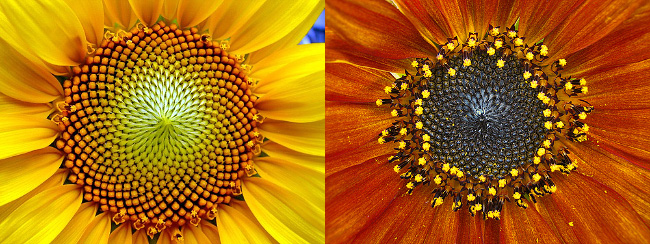
An atom is a pretty stable shape, a combinations of more simple shapes like: electrons, protons, neutrons. Atoms aren't the most simple shapes in the hierarchy of shapes, nor are electrons, protons, neutrons. What are the basic elements isn't exactly clear yet. The character of the basic elements and lowest level shapes is very important to discover, as they define the character of ALL more complex shapes, like you and me and the world we live in.
The whole chemistry thing is about the joining and bounding of atoms. Bound atoms are shapes we call molecules. In the hierarchy of shapes, molecules are at a higher level than atoms. Certain combinations of molecules join together and form stable shapes we call living cells. Biological living cells are at a higher level than molecules. The billions of cells in what we call our human body, are joint. People join together, live and work together, ..not always, but next to being individuals we often work together and accomplish things one individual couldn't. One of the things that working together has accomplished is technology; materials, tools, machines. Nobody knows exactly how all the stuff around us is made. A computer is among the most complex shapes humans have created. They are of a higher level then large groups of people, in the hierarchy of shapes. Take away the humans, and gone is the technology.
When truly autonomous robots are developed by us, something strange could happen: If they are so advanced that they can survive without humans, build and develop themselves, they would not only be higher in the hierarchy of shapes than people, they could also live independent of people. Similar steps have occurred all throughout the history: shapes creating other kinds of independent shapes.
|
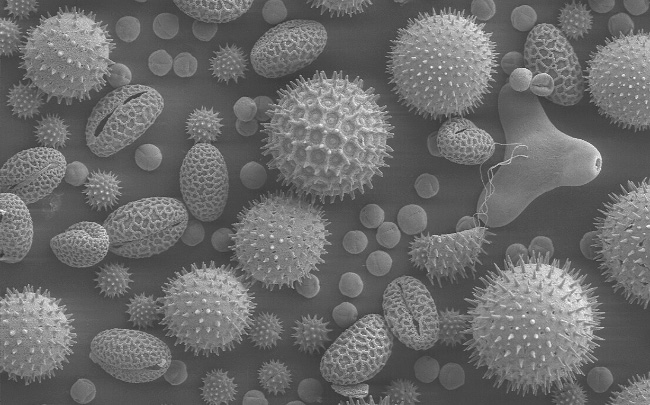 12 Pollen Mix. Source: Dartmouth Electron Microscope Facility
12 Pollen Mix. Source: Dartmouth Electron Microscope Facility
Destruction and Creation.
When all shapes are destroyed, only the basic elements survive. Was there was a very turbulent beginning in the history of this universe? In such energetic situation, shapes can't survive. In a less energetic situation, caused for example by expansion (the spreading of energy) more complex shapes can form and survive longer. In a calm situation, very complex shapes can form. In a frozen situation, shapes can't form, nor can't they be destroyed.
The higher levels are build up on lower levels. When for example all the level 14 shapes within a level 22 shape are destroyed, all shapes higher than level 14 will also be destroyed, but all the lower than level 14 shapes can survive. To destroy is easier than to create. Destruction is thereby more common then creation.
A solutions to kind of escape from destruction is for a shape to create a new shape, similar to how itself began. Reproduction. The whole love sex and children thing. An other option is to clone, a shape that can make an exact copy of itself, or more likely; a repaired copy. Shapes that can't reproduce or clone itself, or be created by an other shape, will be destroyed by the decay caused by the interaction with other shapes. Only the ones that have a solution will survive as a kind and be able to continue the road of creation.
The chance of a very high level shape being created suddenly by chance, is very very small, near to impossible. The road to very complex shapes is very likely to slowly go from simple to more complex. People wonder about how large steps in evolution occurred. Like the step from a soup of molecules to a single cell organism. I wonder about that anyhow (do you?). To say it came from an other planet or it was made by God is not a good answer, unless you want to stop thinking about it. The step is so large, like a city arising in a desert, just by coincidence. That's unbelievable. There must be steps in between or an other more complex shape that created it. But if an other shape created it, how did that shape came to be?
Enemies and Friends.
How about a period of hardly any "enemies" and lost of "friends". That would bring the chance of a complex shape created by chance up to a plausible level.
What is an enemy? Imagine two shapes. One being the combination AAB and one being ABA. Both are pretty stable, but when getting in close contact, they interact and result in AAB and AB and A. Then AAB is the enemy of ABA. Because when they interact, AAB survives and ABA is destroyed. That doesn't make AAB better or worse, it's just like that. If ABA is a vital part of a more complex shape, that more complex shape can't be created with much AAB around.
Friends. If ABA can bound with BBA, but only when AAA is in close contact also, than AAA is a friend of that creative process.
A shape can be an enemy and friend at the same time. It's relative and this enemy and friend part has nothing to do with good or bad.
Combinations and Chance.
Very simple shapes like the 4 combinations of level 2 (AA, AB, BA, BB) can arise easily by chance, in an energetic soup of A and B. But a join of two level 2 shapes, can occur only after the creation of the level 2 shapes, or simultaneous. The chance of simultaneous creation of a complex shape and all it's less complex shapes, is much smaller than growing from less to more complex. But not impossible. Could a single cell living organism have come to life by just random chance? Not likely.
|
 Galaxies. Photo made with the Hubble Space Telescope Source: NASA
Galaxies. Photo made with the Hubble Space Telescope Source: NASA
Not Random.
A universe that contains more than one type of basic element, has a natural tendency to some level of order. Like gravity in our universe. Gravity brings atoms together to from planets and stars. It separates the atoms according to weight: air, water, stone. People don't live at random locations in space, we usually live on the stone-air border, in the air part. The chance of a high level creation occurring is much higher than could be expected in a random chaos of basic soup. Like ice crystals, when water cools down, they arise.
More different higher levels.
If the amount of simple shapes is limited, there are more simple combinations than complex combinations. But there are much more different complex combinations possible than simple ones.
The quality of shapes.
Bigger or more complex isn't equal to better. Quality... what is quality? That can be very subjective. More objective would be to measure how pure the structure is, how few random elements it contains, how well it is organized. I wonder what shape the highest possible quality or level would be like. Should we strive to create that shape? If we can we'll probably do so, some day. We are curious, we boldly go where no human has gone before. Boldly or blindly, we usually have no clue where we are going.
So, what are the "holy" proportions, what is the exact character of "God"?
Yep, that's the question. Possibly the most important scientific question.
I think we can discover it.
Where can we find the right clues to the character of the basic elements?
We (well... not me personally) are working on "the theory of everything".
I think the circle is important, so: Pi. Remember it from high school? "The ratio of a circle's area to the square of its radius."
The ratio: 3.14159265358979323846…
And Phi, "the golden ratio", the ratio that can be found in nature a lot. "a+b is to a as a is to b"
The ratio: 1.6180339887...
And Phi's Fibonacci sequence: 0, 1, 1, 2, 3, 5, 8, 13, 21, 34, 55, 89, 144, 233, 377, 610, 987, …
Maybe the powers of two, because cells multiply like that: 1, 2, 4, 8, 16, ...
Maybe Marko Rodin's vortex-based mathematics? |
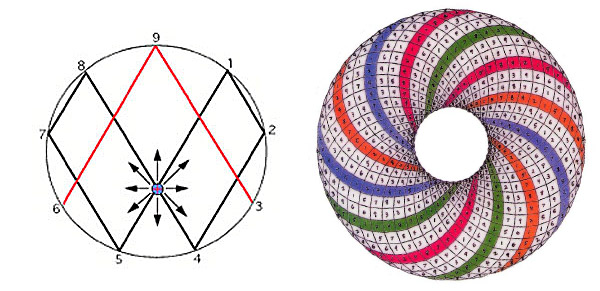 |
Let's play around with circles/balls.
The results can be like "the flower of life" and such. |
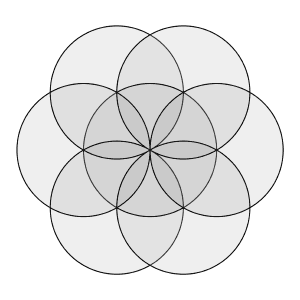 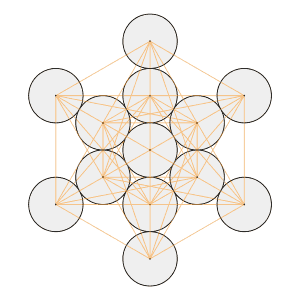 |
Probably most useful clues can be found in chemistry, the knowledge of how atoms and molecules are. |
|
|







